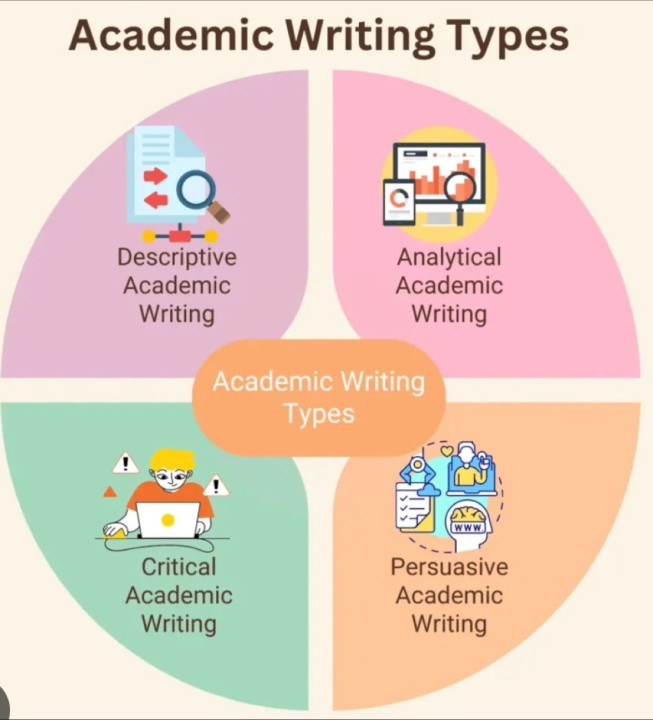Overview
Have you ever dreamt of being a professional researcher, an academic writer or publishing quality articles? With academic writing you will be able to achieve that dream! Writing that conveys thoughts, facts, and research to a more comprehensive academic audience is known as academic writing. Academic writing can be classified into two categories: expert academic writing, which is writing meant for publication in an academic journal or book, and student academic writing, which is used as a form of assessment at universities and in schools as preparation for university study. The same standards apply to both student and expert academic writing, which can be challenging for students to master. (Smith, 2022) Academic Writing is clear, concise, focused, structured and backed up by evidence.
Academic Writing Features

Academic writing in English is linear, focusing on a single central point or theme with each part contributing to the main argument, avoiding digressions and repetitions. Its primary goal is to inform, not entertain, and it adheres to the standard written form of the language. Five main features of academic writing are often highlighted: it uses language precisely and accurately, and it is well-organized and carefully planned. (Features of Academic Writing, n.d.)
Complex
Written language is relatively more complex than spoken language. Written language has longer words, it is lexically more dense and it has a more varied vocabulary. It uses more noun-based phrases than verb-based phrases. Written texts are shorter and the language has more grammatical complexity, including more subordinate clauses and more passives.
Objective
Written language is typically more objective than personal, using fewer references to the writer or reader. The focus should be on the information being presented and the arguments being made, not on the author. Consequently, academic writing often favors nouns and adjectives over verbs and adverbs.
Specific
In academic writing, facts and figures are presented with precision and accuracy. This ensures that the information conveyed is clear and reliable, reflecting the exact data and details necessary for thorough understanding and analysis.
Concise
In academic writing, it is better to be brief and meaningful. Avoid writing out of the initial topic that you were supposed to write.
Formal
Academic writing is relatively formal, meaning that essays should generally avoid using colloquial language and expressions.

Types of academic writing
There are 4 main types of academic writing types which are descriptive, analytical, persuasive and critical:
In many academic texts, you will need to use more than one type of writing. For example, in an empirical thesis, critical writing is used in the literature review to highlight gaps or opportunities in existing research. The methods section is primarily descriptive, summarizing the methods used to collect and analyze information. The results section combines descriptive and analytical writing to report the data collected. Finally, the discussion section is more analytical, as it relates the findings back to the research questions, and also persuasive, as it proposes interpretations of the findings. (Types of Academic Writing, 2022)
Descriptive
The simplest form of academic writing is descriptive, aimed at presenting facts or information. Examples include summarizing an article or reporting the results of an experiment.
Instructions for a purely descriptive task might include: ‘identify’, ‘report’, ‘record’, ‘summarize’, and ‘define’.
Analytical
University-level texts are rarely purely descriptive; most academic writing is also analytical. Analytical writing involves describing facts and information and then reorganizing them into categories, groups, parts, types, or relationships.
These categories or relationships might be established within the discipline, or you might create them for your text. For instance, when comparing two theories, you could analyze how each addresses social context, language learning, and practical application.
Instructions for analytical assignments include: ‘analyze’, ‘compare’, ‘contrast’, ‘relate’, and ‘examine’.
To enhance analytical writing:
Plan thoroughly. Brainstorm facts and ideas, and group them by patterns, similarities, and differences using tools like color-coding, flow charts, or tables.
Name the relationships and categories you identify, such as advantages and disadvantages.
Organize each section and paragraph around an analytical category.
Clarify your paper’s structure with topic sentences and a clear introduction.
Persuasive
In academic writing, you often move beyond analytical writing to persuasive writing. Persuasive writing includes analyzing information and adding your own point of view. Most essays are persuasive, and even research articles contain persuasive elements, especially in the discussion and conclusion sections.
In persuasive writing, you support each claim you make with evidence, such as research findings or published sources. Instructions for persuasive assignments may include: ‘argue’, ‘evaluate’, ‘discuss’, and ‘take a position’.
To form your own point of view:
Read various researchers’ perspectives on the topic and consider which is most convincing.
Identify patterns in the data or references to determine where the evidence is strongest.
Explore different interpretations and their real-life implications.
Discuss the facts and ideas with others to refine your viewpoint.
To develop your argument:
List reasons for your point of view.
Consider different types and sources of evidence to support your stance.
Compare your perspective with those of other researchers.
Break down your argument into parts, such as cost effectiveness or environmental sustainability.
When presenting your argument:
Ensure your text presents a coherent argument that supports your overall viewpoint.
Make your reasoning clear to the reader.
Validate your assumptions.
Provide evidence for every claim, ensuring it is convincing and directly relevant.
Critical
Critical writing, typical in research, postgraduate, and advanced undergraduate writing, encompasses persuasive writing but includes multiple viewpoints, including your own. While persuasive writing necessitates having your own perspective, critical writing requires considering at least two viewpoints.
For instance, you might explain a researcher’s argument and then assess its strengths and weaknesses, or propose an alternative interpretation.
Examples of critical writing assignments include critiquing a journal article or conducting a literature review to assess existing research. Instructions for critical writing may include: ‘critique’, ‘debate’, ‘disagree’, and ‘evaluate’.
To accomplish critical writing:
Summarize the work accurately, including main interpretations, assumptions, or methodology.
Formulate an opinion about the work, such as identifying problems, suggesting improvements, or defending it against criticism.
Support your viewpoint with evidence, which may include logical reasoning, reference to authoritative sources, or research data, depending on the assignment and discipline.

Tips!
Write To Specific Audiences
When writing a research paper, it is crucial to consider your audience. Who will be reading your paper, and what are their expectations? Will it be read by fellow researchers, scholars, or a general audience? Understanding your audience will help you tailor your writing style, tone, and language to effectively communicate your message.
Use Visual Aids
Visual aids like graphs, charts, and tables can clarify intricate data and enhance reader comprehension. However, it’s crucial to employ them judiciously and avoid overwhelming your paper with excessive visuals.
Academic Language Is a Must
Academic language comprises specialized vocabulary utilized in academic writing, encompassing technical terms, jargon, and formal language. Employing suitable academic language can enhance the credibility of your research and elevate the professionalism of your writing.
Storytelling
Utilizing storytelling is an effective technique for captivating readers and rendering your research more relatable. Integrating anecdotes, case studies, or personal experiences enables your audience to establish emotional connections with your research.
(Areas of Academic Writing Worth Researching: Mastering Effective Writing for Researchers, 2021)
Summary
Academic writing is a structured form of communication designed to inform and engage a scholarly audience. It prioritizes clarity, precision, objectivity, specificity, and formality, adhering to standard language conventions. Different types of academic writing, such as descriptive, analytical, persuasive, and critical, serve distinct purposes and require unique approaches. Understanding the target audience is crucial for tailoring style, tone, and language effectively. Visual aids enhance comprehension but should be used judiciously. Academic language, including technical terms and formal language, adds credibility to research. Storytelling can also be a powerful tool for engaging readers and making research relatable, fostering emotional connections. Overall, mastering academic writing basics is essential for researchers, scholars, and students to effectively communicate ideas and contribute to scholarly discourse.
References
Areas of Academic Writing Worth Researching: Mastering Effective Writing for Researchers. (2021, December 28). Research leap. Retrieved May 20, 2024, from https://researchleap.com/academic-writing-101-mastering-the-basics-of-effective-writing-for-research-papers/
Features of Academic Writing. (n.d.). UEfAP. Retrieved May 22, 2024, from https://www.uefap.com/writing/feature/featfram.htm
Smith, S. (2022, July 24). What is Academic Writing? EAP Foundation. Retrieved May 22, 2024, from https://www.eapfoundation.com/writing/what/
Types of academic writing. (2022, October 26). The University of Sydney. Retrieved May 22, 2024, from https://www.sydney.edu.au/students/writing/types-of-academic-writing.html
